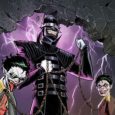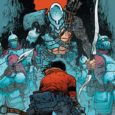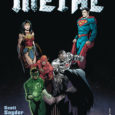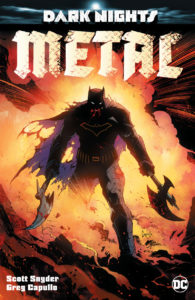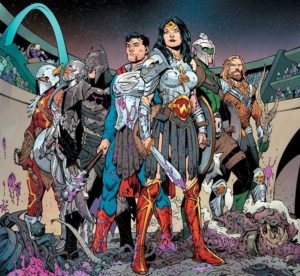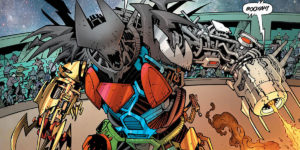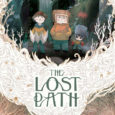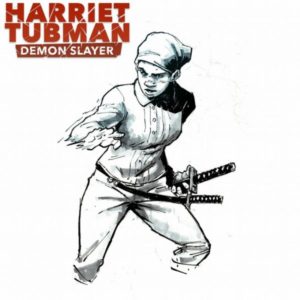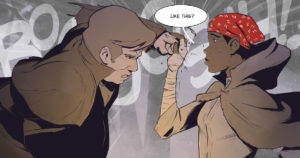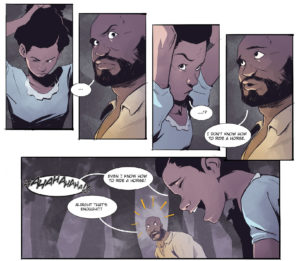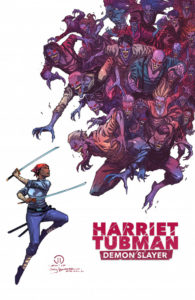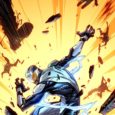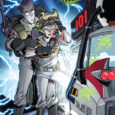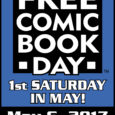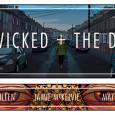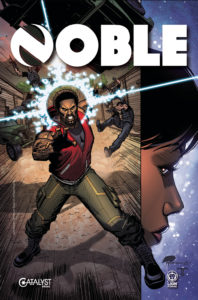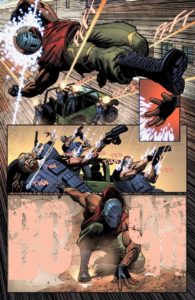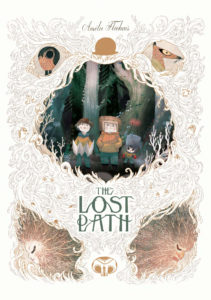 Adventure stories for children starring children will never go out of style. From Alice’s Adventures in Wonderland to The Neverending Story to Goonies, there’s a great thrill in young ones being able to see themselves as the protagonists in exciting situations. The Lost Path by Amélie Fléchais is one such tale in which a trio of boys find themselves in the thick of a secret world of strange and wondrous creatures, but how does it measure up to some of the classics?
Adventure stories for children starring children will never go out of style. From Alice’s Adventures in Wonderland to The Neverending Story to Goonies, there’s a great thrill in young ones being able to see themselves as the protagonists in exciting situations. The Lost Path by Amélie Fléchais is one such tale in which a trio of boys find themselves in the thick of a secret world of strange and wondrous creatures, but how does it measure up to some of the classics?
With some writing help by Jonathan Garnier, The Lost Path is written and illustrated by Fléchais. The book opens with a fairy tale of an older couple whose spirits are trapped by the forest before it quickly transitions to boys playing a scavenger hunt in the forest. They get lost and as the night grows darker, they find their situation growing stranger as they move deeper into the forest.
The story itself feels heavily influenced by Where the Wild Things Are, a notion that is supported by the Maurice Sendak quote that proceeds the book. The boys interact with the creatures, not understanding the world that they’ve arrived in, and with no understanding of the dangers they face. In addition to this, I find a lot of influence from Alice’s Adventures in Wonderland in the way the plot revolves around the forest guardian and the quest for the crown. Both of these are ideal stories to draw inspiration from for a children’s book of these sorts as they are seminal classics, but I don’t think Fléchais really handled the interpretation of the themes properly.
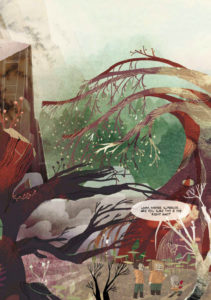 The problem with the story is that the boys don’t do anything. They’re simply reacting to everything that happens around them. They don’t learn any lessons, they don’t affect the world in any way. Their only purpose is to witness the events and they, and by extension the reader, don’t get the chance to see anything through to the conclusion. That’s one of the major shortcomings of the book, in that the story doesn’t really matter. (We don’t even discover the outcome of the scavenger hunt.)
The problem with the story is that the boys don’t do anything. They’re simply reacting to everything that happens around them. They don’t learn any lessons, they don’t affect the world in any way. Their only purpose is to witness the events and they, and by extension the reader, don’t get the chance to see anything through to the conclusion. That’s one of the major shortcomings of the book, in that the story doesn’t really matter. (We don’t even discover the outcome of the scavenger hunt.)
One of the things that turned me off most about The Lost Path was its abrupt ending. While the kids’ journey is an interesting one, the characters they meet are far more intriguing, but Fléchais never dives into any of them. I wanted to learn more about the fox and his supersonic bike, or the moose and how he got the bowler hat, or even what the deal was with the hat. Unfortunately, all of these characters are just incidental, there to give the boys a sense of wonder. Since the story is told from the perspective of the boys, once they are out of the woods, we lose all connection to these strange and wondrous creatures. Their tales are never finished and that’s just a shame.
The book’s art is breathtaking. The illustrations by Fléchais are magnificent and really bring her world and characters to life. Her style suits the creatures she’s created and I love the spin she gives the look of the humans. Each of the boys is unique and easily decipherable at a glance. I also loved the sparse use of color in the book. Most of the pages are black and white, rendered in great detail, but every so often readers are treated to a page of full, vibrant color, which makes the scene more dramatic when juxtaposed against the monochrome panels.
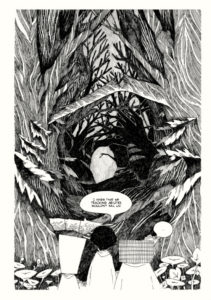 The art also does a great job of slowing down the reader. The Lost Path has a very fast paced story, with so much happening in so few pages that it’s easy to breeze through the whole thing, but the highly detailed art forced me to pause and pour over the details in the minutiae on page, which helped me to digest the story better.
The art also does a great job of slowing down the reader. The Lost Path has a very fast paced story, with so much happening in so few pages that it’s easy to breeze through the whole thing, but the highly detailed art forced me to pause and pour over the details in the minutiae on page, which helped me to digest the story better.
The Lost Path is beautiful visually but doesn’t pack much originality. I would have preferred to spend more time with the Guardian, learning about her kingdom, or some of the animals in the forest. It was slightly disappointing that Fléchais gleaned over all of these interesting situations and themes, instead focusing on the boys finding their way home. I understand her decision, though, as this story felt aimed for children. All in all, it’s a good story for those who are interested in child adventure stories but doesn’t offer much depth.
Grade: B-
For a few years back in the early 2010s horror mash up stories were all the rage. Take an innocuous but well known thing and mix it with a fantasy horror trope and a new hit was made. These were most evident through books like Pride and Prejudice and Zombies and Abraham Lincoln: Vampire Hunter and probably a few others not written by Seth Grahame-Smith. Though that genre has been dormant for a few years, it’s come back quite well with the recent release of Harriet Tubman: Demon Slayer.
Written by David Crownson, Harriet Tubman: Demon Slayer takes place (appropriately) in 1860, deep in the heart of America’s days of Slavery. It opens with a slave family, the Edgefields, as they escape their plantation in search of a life as free folk. When they run afoul of a trio of shady white men, the Edgefields stand their ground only to discover that these men aren’t exactly what they seem to be. Luckily, a mysterious stranger, the eponymous Harriet Tubman, shows up to save them.
One of the things I liked most about the book is the humor. Within the first couple of pages, Crownson makes a joke at the expense of one of his characters and it’s brilliant because it serves a higher purpose than a mere moment of levity. In addition to setting the tone for the book, that initial joke lets the audience know that despite the heady subject matter, they’re allowed to laugh at the story. This is a necessary cue for readers like me, a middle class white man, during the times that the N-word gets bandied around. That word would (rightfully so) make modern audiences uncomfortable but was necessary to tell a story that borrowed heavily from the time of slavery and Harriet Tubman’s real-life struggle. Crownson breaks the ice early to alleviate any possible squeamishness.
The art on the book is superb. Courtland Ellis’ art is smooth, his figures realistic and graceful. There are no overly muscular men rippling through torn shirts. His women aren’t bodaciously disproportioned, and in fact have noticeably different body types. Ellis uses subtle facial expressions on his characters to portray emotions and tip the readers off to what they’re thinking, but he’s then able to go all out during the funny moments. It can be a jarring juxtaposition at times but really ramps up the humor.
The art isn’t perfect, though. Most of the pages are beautiful, however, there’s some panel progression that feels off. Some of the character movement is choppy and stilted, which is detrimental in a book that relies heavily on fight scenes. Thankfully, it’s easy to overlook because there are so many other things to enjoy but hopefully it improves as the series progresses.
Ellis also shines in how he draws backgrounds, notably in the way he uses large brushstrokes to signify foliage. It’s drastically different from mainstream comics and I absolutely love it.
My biggest problem with the book is the dialogue. While most of the characters’ speech is smooth and energetic, the story is sprinkled with one-liners that just seem trite and unnecessary. It tended to be more good than bad, though.
I also wasn’t a fan of the localized dialect. This was probably included to show how different groups speak differently and was effective in establishing the world the story takes place in. I felt like it slowed down the reading experience, forcing me to puzzle out what the characters were saying. I understand that I’m splitting hairs here and maybe sound a little pedantic but this was definitely my take away from the reading experience.
Also, I need to point out the book’s poor punctuation. Normally I don’t even notice the lettering in comic books but the fact that this drew my attention means that it really stood out. Granted, some of the punctuation choices may have been stylistic but there are some instances that are just inconsistent, making the lettering come off as lazy or rushed. Again, I have hope that this will be remedied in future issues.
Despite its flaws, though, one thing that Crownson gets right is the mystery surrounding Harriet Tubman: Demon Slayer. His opening chapter focuses on establishing the characters. He doesn’t dive too far into why the vampires are chasing runaway slaves or even where Harriet comes from. We know nothing of her past, her upbringing, or how she knows how to fight. Crownson reveals just enough to whet my appetite but not too much that I lose interest and don’t return for the second issue.
Having purchased Harriet Tubman: Demon Slayer on a whim during Free Comic Book Day (it was funded through a successful Kickstarter), I have no idea how to get a physical copy of the book. However, you can buy it in digital on Comixology and Peep Game Comix. And I wholly recommend you pick it up. Not only is this book a fun read but it’s also an interesting take on the horror mash-up genre and the life of one of the most prolific American humanitarians.
Grade: B-
As one of the smaller independent presses, Lion Forge Comics is not very well known. Most of their line up consists of comics based on popular 80s franchises (as well as a few not-so-popular). As of recently, though, they are jumping into the super hero game, starting with the release of Catalyst Prime: Noble, a prelude to their upcoming Catalyst Prime universe.
The premise behind Catalyst Prime is that a massive asteroid is heading to Earth and only 5 astronauts are able to stop it. It’s a fairly straight forward premise, one that leaves a lot of room to work with. We’ll learn more about what they’re calling “The Event” on Free Comic Book Day when Lion Forge gives out copies of Catalyst Prime: The Event. From there, the Catalyst Prime universe will slowly unfold in seven monthly comic books. One of these is Catalyst Prime: Noble, which focuses on David Powell, one of the astronauts involved in The Event and what becomes of him in the following year.
The main cast of Noble is only two characters, the aforementioned David and his wife, Astrid. Writer Brandon Thomas was wise to structure the introductory chapter like this as it made it easy to follow. Being new characters, we don’t know much about the kind of people David and Astrid are, so throwing a wide cast at new audiences may become confusing and alienate readers. By paring that down to two, especially two who are so closely tied together, Thomas create a far simpler reading experience while getting the most out of the story.
Most of the issue focuses on David, who has no idea who he is but shows some powerful telekinetic abilities, being pursued by a specialized military team. Everything is left ambiguous; we don’t know why David’s on the run, why these men are chasing him, or who the mysterious “she” is that sent them. It’s a well written, well paced scene that’s enhanced by Roger Robinson’s art.
What I like most about the art is Robinson’s style. He uses a lot of lines, most especially in his figures and when indicating motion. It’s very different from a lot of the more mainstream comics and lends the book a gritty feeling. I use “gritty” as it’s supposed to mean; coarse and dirty, not dark and broody as it’s become to be known. Which I mean as a compliment. The scene involved David being chased by a group of large men through a sandy, desert town. One word that should be used to describe this is “gritty.”
The panel progression is very cinematic. From the very first page we get a slow zoom out from Astrid’s wedding ring as she sits nervously in a waiting room. This transitions to a flashback of not long before, revealing the reason she’s nervous. That lasts less than a page before we return to the present moment, when Astrid is given terrible news and breaks down in tears. Three pages is all it takes to recap her harrowing experience losing her husband in The Event and it’s all that’s needed. Wonderful work by both Thomas and Robinson.
I also loved the end twist. It’s a pretty big reveal that most writers would dangle in front of readers, dropping little clues here and there through subsequent issues in order to keep them on the hook. But Thomas tells us up front at the end of the issue who is masterminding the hunt for David. It’s a great reveal because it opens so many more questions that entice readers to come back without resorting to clichés and cheap tricks.
As a fan of super heroes, it’s nice to break away from the worlds of Marvel and DC, which are steeped in so much history that it’s often difficult to keep up. Catalyst Prime offers a reprieve from that, with strong characters that we get to see evolve and grow in real time. It’s also great to see a comic so deftly blend the techniques of filmmaking into its storytelling. I hadn’t heard much about Catalyst Prime before reading Noble but now I’m definitely looking to go deeper into the universe.
Grade: B


